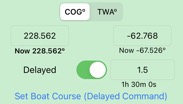
Set your course using Course Over Ground (COG) on the left, or True Wind Angle (TWA) on the right. Make sure to select which command you want to send with the selector on top.
Special note: TWA values must be preceded with a + or - sign.
The numbers below the input boxes indicate the current setting for your boat. The one in bold indicates whether the most recent command was COG or TWA.
If your command would tack or gybe the boat, the panel turns yellow as an extra warning.

A command can be set to execute at some time in the future. Turn the Delayed switch on, and enter a delay value. The panel turns green to indicate a delayed command.
Delay values can take several formats:
- A decimal number indicates hours; for clarity, the hours, minutes and seconds remaining are updated below the input box
- Hours, minutes, and seconds can be entered as, for example, 1h30m or 1h30m20s
- A specific UTC time can be entered as 22:00 or with seconds as 22:10:30
Calculated information
A variety of calculated information is displayed to help you navigate. Press any of the blue numbers to fill in the navigation boxes as appropriate. For VMG ± numbers, clicking again switches the sign in the TWA box.
Note that, for delayed commands, the information displayed is limited to best VMG around the time of the expected calculation, using the predictor line. This may only be an approximation, especially if there are previous delayed commands that would make the predictor location incorrect.
Some items to note:
- VMC is speed toward the next mark, with “Best VMC” indicating optimal direction, if following VMC
- VMG is Velocity Made Good toward either 0º TWA (Upwind) or 180º TWA (Downwind). Best VMG is calculated to the nearest 0.01º
- Time to the next course mark (Time To Wpt) is calculated as distance to that course mark divided by the current VMC
- Rhumb Line measurements indicate a course of constant bearing to the next mark (a straight line on a Mercator projection, as used in this app). Great Circle routes are straight lines on a sphere, and thus represent shorter distance. Bearing to the mark changes over time. The distance difference is noted to the right of the respective distance calculations.
http://www.movable-type.co.uk/scripts/latlong.html